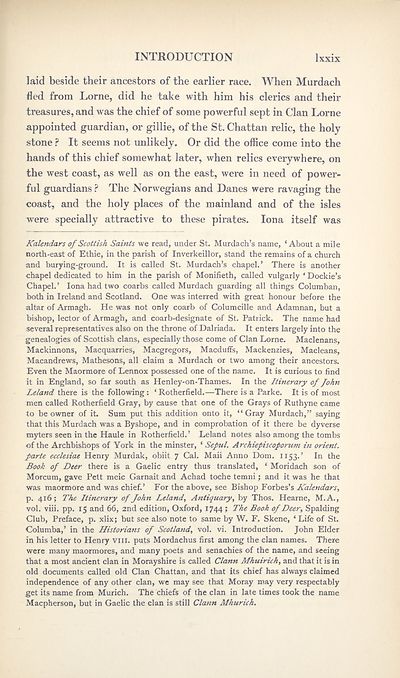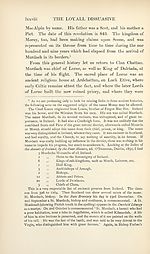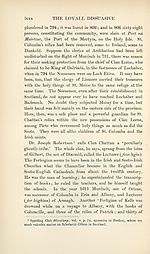Series 1 > Loyall dissuasive
(94) Page lxxix
Download files
Complete book:
Individual page:
Thumbnail gallery: Grid view | List view

INTRODUCTION
Ixxix
laid beside their ancestors of the earlier race. When Murdach
fled from Lome, did he take with him his clerics and their
treasures, and was the chief of some powerful sept in Clan Lome
appointed guardian, or gillie, of the St. Chattan relic, the holy
stone? It seems not unlikely. Or did the office come into the
hands of this chief somewhat later, when relics everywhere, on
the west coast, as well as on the east, were in need of power¬
ful guardians ? The Norwegians and Danes were ravaging the
coast, and the holy places of the mainland and of the isles
were specially attractive to these pirates. Iona itself was
/Calendars of Scottish Saints we read, under St. Murdach’s name, ‘About a mile
north-east of Ethie, in the parish of Inverkeillor, stand the remains of a church
and burying-ground. It is called St. Murdach’s chapel.’ There is another
chapel dedicated to him in the parish of Monifieth, called vulgarly ‘ Dockie’s
Chapel.’ Iona had two coarbs called Murdach guarding all things Columban,
both in Ireland and Scotland. One was interred with great honour before the
altar of Armagh. He was not only coarb of Columcille and Adamnan, but a
bishop, lector of Armagh, and coarb-designate of St. Patrick. The name had
several representatives also on the throne of Dalriada. It enters largely into the
genealogies of Scottish clans, especially those come of Clan Lome. Maclenans,
Mackinnons, Macquarries, Macgregors, Macduffs, Mackenzies, Macleans,
Macandrews, Mathesons, all claim a Murdach or two among their ancestors.
Even the Maormore of Lennox possessed one of the name. It is curious to find
it in England, so far south as Henley-on-Thames. In the Itinerary of fohn
Leland there is the following: ‘ Rotherfield.—There is a Parke. It is of most
men called Rotherfield Gray, by cause that one of the Grays of Ruthyne came
to be owner of it. Sum put this addition onto it, “ Gray Murdach,” saying
that this Murdach was a Byshope, and in comprobation of it there be dyverse
myters seen in the Haule in Rotherfield.’ Leland notes also among the tombs
of the Archbishops of York in the minster, ‘ Sepul. Archiefiscoporum in orient,
parte ecclesiae Henry Murdak, obiit ^ Cal. Maii Anno Dom. 1153.’ In the
Book of Deer there is a Gaelic entry thus translated, ‘ Moridach son of
Morcum, gave Pett meic Garnait and Achad toche temni; and it was he that
was maormore and was chief.’ For the above, see Bishop Forbes’s /Calendars,
p. 416; The Itinerary of fohn Leland, Antiquary, by Thos. Hearne, M.A.,
vol. viii. pp. 15 and 66, 2nd edition, Oxford, 1744 ; The Book of Deer, Spalding
Club, Preface, p. xlix; but see also note to same by W. F, Skene, ‘ Life of St.
Columba,’ in the Historians of Scotland, vol. vi. Introduction. John Elder
in his letter to Henry vm. puts Mordachus first among the clan names. There
were many maormores, and many poets and senachies of the name, and seeing
that a most ancient clan in Morayshire is called Clann Mhuirich, and that it is in
old documents called old Clan Chattan, and that its chief has always claimed
independence of any other clan, we may see that Moray may very respectably
get its name from Murich. The chiefs of the clan in late times took the name
Macpherson, but in Gaelic the clan is still Clann Mkurich.
Ixxix
laid beside their ancestors of the earlier race. When Murdach
fled from Lome, did he take with him his clerics and their
treasures, and was the chief of some powerful sept in Clan Lome
appointed guardian, or gillie, of the St. Chattan relic, the holy
stone? It seems not unlikely. Or did the office come into the
hands of this chief somewhat later, when relics everywhere, on
the west coast, as well as on the east, were in need of power¬
ful guardians ? The Norwegians and Danes were ravaging the
coast, and the holy places of the mainland and of the isles
were specially attractive to these pirates. Iona itself was
/Calendars of Scottish Saints we read, under St. Murdach’s name, ‘About a mile
north-east of Ethie, in the parish of Inverkeillor, stand the remains of a church
and burying-ground. It is called St. Murdach’s chapel.’ There is another
chapel dedicated to him in the parish of Monifieth, called vulgarly ‘ Dockie’s
Chapel.’ Iona had two coarbs called Murdach guarding all things Columban,
both in Ireland and Scotland. One was interred with great honour before the
altar of Armagh. He was not only coarb of Columcille and Adamnan, but a
bishop, lector of Armagh, and coarb-designate of St. Patrick. The name had
several representatives also on the throne of Dalriada. It enters largely into the
genealogies of Scottish clans, especially those come of Clan Lome. Maclenans,
Mackinnons, Macquarries, Macgregors, Macduffs, Mackenzies, Macleans,
Macandrews, Mathesons, all claim a Murdach or two among their ancestors.
Even the Maormore of Lennox possessed one of the name. It is curious to find
it in England, so far south as Henley-on-Thames. In the Itinerary of fohn
Leland there is the following: ‘ Rotherfield.—There is a Parke. It is of most
men called Rotherfield Gray, by cause that one of the Grays of Ruthyne came
to be owner of it. Sum put this addition onto it, “ Gray Murdach,” saying
that this Murdach was a Byshope, and in comprobation of it there be dyverse
myters seen in the Haule in Rotherfield.’ Leland notes also among the tombs
of the Archbishops of York in the minster, ‘ Sepul. Archiefiscoporum in orient,
parte ecclesiae Henry Murdak, obiit ^ Cal. Maii Anno Dom. 1153.’ In the
Book of Deer there is a Gaelic entry thus translated, ‘ Moridach son of
Morcum, gave Pett meic Garnait and Achad toche temni; and it was he that
was maormore and was chief.’ For the above, see Bishop Forbes’s /Calendars,
p. 416; The Itinerary of fohn Leland, Antiquary, by Thos. Hearne, M.A.,
vol. viii. pp. 15 and 66, 2nd edition, Oxford, 1744 ; The Book of Deer, Spalding
Club, Preface, p. xlix; but see also note to same by W. F, Skene, ‘ Life of St.
Columba,’ in the Historians of Scotland, vol. vi. Introduction. John Elder
in his letter to Henry vm. puts Mordachus first among the clan names. There
were many maormores, and many poets and senachies of the name, and seeing
that a most ancient clan in Morayshire is called Clann Mhuirich, and that it is in
old documents called old Clan Chattan, and that its chief has always claimed
independence of any other clan, we may see that Moray may very respectably
get its name from Murich. The chiefs of the clan in late times took the name
Macpherson, but in Gaelic the clan is still Clann Mkurich.
Set display mode to:
![]() Universal Viewer |
Universal Viewer | ![]() Mirador |
Large image | Transcription
Mirador |
Large image | Transcription
Images and transcriptions on this page, including medium image downloads, may be used under the Creative Commons Attribution 4.0 International Licence unless otherwise stated. ![]()
| Scottish History Society volumes > Series 1 > Loyall dissuasive > (94) Page lxxix |
|---|
| Permanent URL | https://digital.nls.uk/127548133 |
|---|
| Attribution and copyright: |
|
|---|
| Description | Over 180 volumes, published by the Scottish History Society, containing original sources on Scotland's history and people. With a wide range of subjects, the books collectively cover all periods from the 12th to 20th centuries, and reflect changing trends in Scottish history. Sources are accompanied by scholarly interpretation, references and bibliographies. Volumes are usually published annually, and more digitised volumes will be added as they become available. |
|---|


